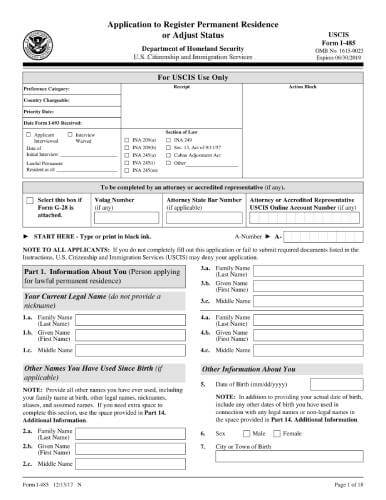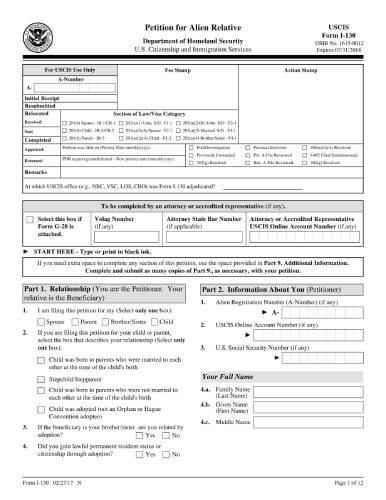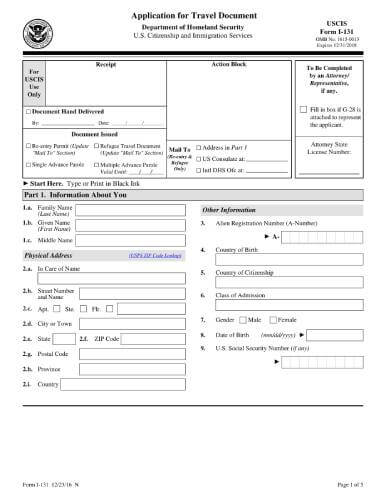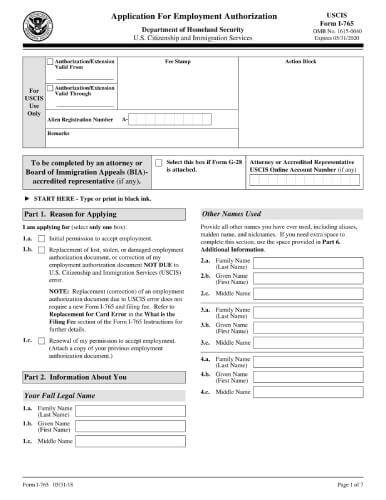Form I-485 plays a pivotal role in the journey towards obtaining a green card. Officially known as the Adjustment of Status Application, this form is utilized by individuals who are already in the United States on a valid nonimmigrant visa and are eligible to transition to lawful permanent residency.
In this article, we delve into the significance of Form I-485 in the green card application process, outlining eligibility criteria, exclusions, associated costs, processing times, and the necessary documentation.
Overview of Form I-485
Form I-485, the official green card application, enables certain immigrants, including special categories like asylees, to apply for a change in their immigration status while in the United States. To adjust your status, you must be physically present in the U.S. and submit Form I-485. In order to expedite the application process, U.S. Citizenship and Immigration Services (USCIS) permits "concurrent filing," which is the filing of Form I-485 concurrently with Form I-130.
For those outside the United States, the green card application must be processed through the consular process in their home country. This requires coordination with the local U.S. embassy or consulate, as detailed in the Department of Homeland Security's (DHS) directory of international offices.
Understanding the requirements and correctly filing Form I-485 can significantly impact the success and timing of your application for permanent residency. This form is not just a procedural step but a critical component of your journey towards establishing permanent roots in the United States. By familiarizing yourself with the process and preparing your application thoroughly, you can navigate this path with greater confidence and clarity.
Eligibility for Filing Form I-485
Who Can File?
Under the Immigration and Nationality Act (INA), the eligibility to file Form I-485, or the Adjustment of Status Application, is restricted to certain immigrants who meet specific criteria. Those eligible to apply for a green card fall into various categories defined by USCIS, including family-based, humanitarian, or employment-based grounds.
For a family-based green card, applicants must be immediate relatives of either a U.S. citizen or a lawful permanent resident. This category includes spouses, parents, or children of citizens or green card holders. Applicants must be physically present in the United States and must have entered the country on a valid nonimmigrant visa. Refugees and asylees are eligible to adjust their status to a humanitarian green card after residing in the United States for at least one year. Additionally, foreign nationals employed by certain U.S. employers may seek an employment-based green card by filing Form I-485.
Who Cannot File?
However, not all individuals can file Form I-485. Immigrants who are family members of U.S. citizens but are not currently in the United States are ineligible. According to USCIS, you are also barred from filing if you:
- Entered the United States as a crewman,
- Were in transit to another country,
- Entered the U.S. as a witness or informant,
- Are in removal proceedings related to terrorism charges.
Furthermore, several grounds of "inadmissibility" can prevent the filing of Form I-485. These include:
- Health-related issues, such as certain mental health conditions or communicable diseases,
- Criminal records involving specific offenses,
- Security concerns, if deemed a threat to U.S. national security,
- Violations of U.S. immigration laws,
- Other reasons, such as intentions to practice polygamy, involvement in child abduction, or unlawful voting.
Waivers for some of these inadmissibility grounds may be available depending on the relationship between the petitioner and the applicant, as well as the category of the green card being applied for. If you believe a waiver might be necessary, consulting with an immigration attorney is advisable to navigate this complex aspect of your application effectively.
Understanding the Costs and Requirements for Filing Form I-485
Filing Costs for Form I-485
The filing fee for Form I-485, which you must pay when submitting the form to USCIS, is $1,225. This total includes a fee for biometrics processing. Payment can be made via money order, personal check, or cashier’s check. It's important to note that the filing fee may vary depending on the applicant's age and specific circumstances. For example, refugees are exempt from the filing fee, and applicants under 14 years old filing with the application of at least one parent pay a reduced fee. For detailed information on fees applicable to different categories, visit the USCIS website.
Required Supporting Documents
When filing Form I-485 to adjust your status and obtain a green card, you must include various supporting documents to substantiate your eligibility:
- Visa and Travel Records: Attach a copy of the visa used to enter the United States and the I-94 travel record to demonstrate lawful entry.
- Proof of Nationality: Include a copy of your birth certificate and your foreign passport.
- Financial Support Evidence: Provide documentation of the sponsor’s financial ability to support you, such as the sponsor's recent federal income tax returns and pay stubs, accompanied by an Affidavit of Support.
- Legal Records: If you have been arrested, include a certified copy of the court record to prove that there was no conviction.
- Medical Examination Results: Submit the results of an immigration medical examination, conducted by a USCIS-approved doctor, which you can locate using the USCIS ‘find a doctor’ tool.
The primary objectives of these supporting documents are to verify the sponsor's valid U.S. permanent residency or citizenship status and to confirm the genuine relationship between the sponsor and the applicant. All documents submitted to USCIS must be in English, or accompanied by certified English translations as per USCIS requirements.
By carefully preparing and submitting the appropriate documentation and fees, you can facilitate a smoother processing of your Form I-485 application, moving you closer to obtaining permanent residency in the United States.
If you're unable to provide the required supporting documents for Form I-485, USCIS allows the submission of alternative documents, also known as secondary evidence. For instance, if your original birth certificate is unavailable, you can substitute it with alternative forms of documentation. The U.S. government outlines acceptable types of secondary evidence on the State Department website.
Should primary documents like birth certificates be unattainable, you can obtain an official statement from your home country's relevant authority, declaring that the document is not available. Suitable replacements might include school records or census records that indicate your date of birth, place of birth, and parents' names. If these alternatives are also unavailable, you may provide affidavits from two individuals who have personal knowledge of your birth.
Submitting Form I-485
Once you have gathered all necessary forms, supporting documents, and prepared the filing fee, you should compile everything into a single packet for submission. It is advisable to keep copies of all documents you submit, as originals should not be sent to USCIS unless specifically requested, to avoid the risk of losing important documents.
Form I-485 can be filed either online or by mail:
- Online Submission: Create a MyUSCIS account on the USCIS website to submit your form online. This method allows you to track the status of your application via your alien registration number (A-number).
- Mail Submission: If you choose to submit by mail, the specific lockbox facility you should use depends on your location and the postal service you choose. Detailed instructions and addresses for these lockbox facilities can be found on the USCIS website.
By following these guidelines and utilizing alternative documentation where necessary, you can effectively manage the submission process for Form I-485.
Processing Timeline for Form I-485 Approval
The approval timeline for Form I-485, managed by the U.S. Citizenship and Immigration Services (USCIS), varies based on the specific adjustment category you belong to. Generally, you can expect to receive receipt notices about six weeks after submission. Following this, USCIS will schedule a biometrics appointment at a local Application Support Center (ASC) where you will provide your photo and fingerprints for security purposes.
In conjunction with filing Form I-485, you may also submit applications for a travel document or advance parole (Form I-131) and for employment authorization (Form I-765). Typically, the Employment Authorization Document (EAD) and Travel Document are issued within six to eight months.
The decision on your green card application is expected within 12-18 months, provided your priority date is current. Once your immigrant petition is approved by USCIS, your green card will be mailed to you within 30 days of the approval notice. Additionally, you will be required to attend a green card interview at a local USCIS office, where the interviewing officer will finalize the decision on your application.
The processing of your case might involve the National Visa Center (NVC), which is a part of the U.S. Department of State. The NVC holds U.S. immigrant visa petitions approved by USCIS until an immigrant visa number is available. Depending on the nature of your application and external factors such as the pandemic, the processing times can vary. Remember, staying informed and prepared for each step of the process can help alleviate some of the uncertainty and stress associated with immigration procedures.
Last Updated 09/13/24 10:33:52AM


 Form I-485 | Application to Register Permanent Residence or Adjust Status
Form I-485 | Application to Register Permanent Residence or Adjust Status
 Form I-130 | Petition for Alien Relative
Form I-130 | Petition for Alien Relative
 Form I-131 | Application for Travel Document
Form I-131 | Application for Travel Document
 Form I-765 | Application for Employment Authorization
Form I-765 | Application for Employment Authorization